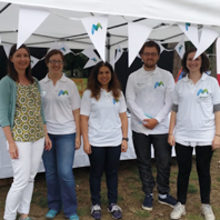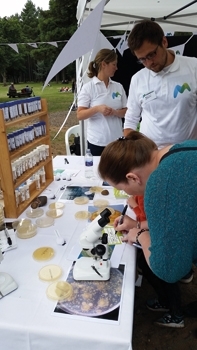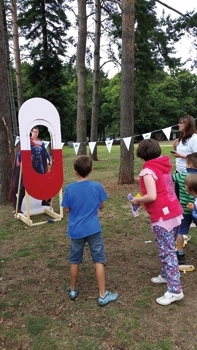Outreach: Small World Initiative – pop-up events
Issue: Zoonotic diseases
05 November 2015 article

It has been a year since the Society launched the Small World Initiative in the UK and Ireland on European Antibiotic Awareness Day 2014 and a lot has happened since then!
The Small World Initiative will give the general public, students and educators in the UK and Ireland the opportunity to work with scientists as part of a global initiative to discover new antibiotics from soil bacteria.

We have run a successful pre- pilot school partnership with the University of East Anglia and the Sir Isaac Newton Sixth Form College in Norwich, with participating students coming to our Annual Conference and presenting their work at the poster session. We have run a summer school for six undergraduate programmes and seven school partnerships, which have started their programmes in this new academic year. We have also chosen the University of East Anglia to host our match-funded PhD student, Ethan Drury, who will be working on a citizen science project as part of the Small World Initiative.
Ahead of the start of the PhD project, the Society ran two pop-up science events in August to launch the citizen science project, in collaboration with the Forestry Commission and Forest Research. The events took place at High Lodge Forest Centre and Alice Holt Forest. People visiting the event could take a sampling kit around the forest with them, collect a soil sample and prepare a spread plate of their sample when they returned to see the bacteria present in the soil, before depositing the sample in our soil bank, which was then sent to Dr Matt Hutchings’ laboratory at the University of East Anglia for analysis.
Visitors to the stand were welcomed by a team of expert volunteers, who talked with people about hunting for new antibiotics in the soil, how we find these medicines and the threat of antibiotic resistance. They could look at agar plates down the microscope that contained pre-prepared soil samples and also plates containing Streptomyces strains, which are the source of numerous antibiotics in common use. Interested visitors could also look at micrograph pictures of various microbes and guess whether antibiotics were effective against them or not. There was also a physical challenge, where children could throw giant microbes at an antibiotic pill, which got more ineffective the more microbes were thrown at it. But by far the most popular part of the stand was the science itself.

The project gained interest in the local media, with appearances on BBC Radio Norfolk and BBC Radio Surrey, and television slots on BBC Look East and BBC South Today. Lots of visitors to the stand had seen the project on local television and were keen to find out more and be a part of the project.
People of all ages enjoyed collecting their sample, and prepping it ready for further analysis. We were really pleased to see the enthusiasm from people who are following the analysis online. Results of the experiments have been shared on the Society’s website and the dedicated Facebook page. Even if you didn’t manage to join us in the forests, please check out the website and Facebook page and see if you can spot any potential antibiotics on our samples!
The Society would like to thank Forest Research and the Forestry Commission for hosting the events. We would also like to thank Dr Matt Hutchings and his team at the University of East Anglia for providing agar plates for the stand and for providing laboratory support for the sample analysis. We also thank Dr Paul Hoskisson for providing plates of Streptomyces cultures for the stand, Dr Laura Bowater for joining us on the stand at the High Lodge event, our President Professor Nigel Brown and Forest Research staff Sue Benham and Peter Crow for volunteering with us at Alice Holt and all the other volunteers and Society staff who joined us for the two events. Their hard work and enthusiasm made it a success.
THERESA HUDSON
Education and Outreach Manager
[email protected]
Image: First image is the Small World Initiative team at High Lodge Forest Centre. Second image Society champion Ben Johns taking another sample into the soil bank. Third image demonstrating antibiotic resistance through attacking Superman with giant microbes! .
